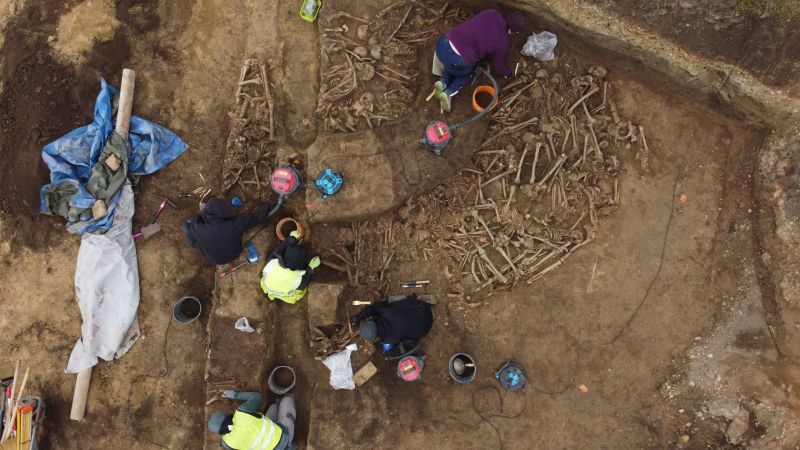In a remarkable archaeological discovery, the renovation of a football pitch in Simmering, a district in Vienna, Austria, has led to the unearthing of a Roman mass grave containing the bones of over 100 soldiers who met their demise during combat. This noteworthy event took place in late October, as reported by the Vienna Department of Urban Archaeology, which operates under the Wien Museum. The excavation work was carried out by archaeologists and anthropologists from the museum in collaboration with professionals from the archaeological excavation firm, Novetus.
Excavations at the site revealed an estimated 129 individual remains, although experts believe the true number could exceed 150 due to earlier construction activities that had disturbed the burial ground. The skeletal findings pointed to a hurried interment process; the museum noted that the bodies were not arranged in a systematic manner. Instead, the limbs of the deceased were intermingled, with many bodies positioned on their stomachs or sides, once again emphasizing the chaotic circumstances surrounding their burial.
Upon thorough examination, it was determined that all the remains belonged to male individuals, the majority of whom were more than 1.7 meters tall (5 feet 7 inches) and were aged between 20 and 30 years at the time of their deaths. Interestingly, while their dental health appeared to be generally good—with few indications of infections—each person analyzed displayed skeletal injuries consistent with battle wounds rather than execution, dispelling any notion of these individuals being victims of military punishment.
The injuries uncovered indicated they were inflicted during combat; primarily situated in the skull, pelvis, and torso, these wounds were consistent with being struck by various weaponry, including spears, daggers, swords, and iron projectiles. This further confirmed the absence of any association with a military hospital or epidemic as a probable cause of death.
Dating the remains suggests they date back to approximately 80 to 230 AD, a crucial period in early Roman history. The museum also indicated that the deceased soldiers likely had their weapons taken from them since only a few objects were found in their graves. Some artifacts excavated included iron spearheads, hobnails which would have adorned the bases of leather Roman military shoes, and the remains of a rusted iron dagger adorned with classical Roman decorative elements, marking its dating to between the mid-1st century and early 2nd century AD.
Among the extraordinary finds were several fragments of scale armor typical around 100 AD, though these were noted for their distinct square shapes as opposed to the conventional round ones. A cheek piece from a Roman helmet was also discovered, indicative of a style that emerged during the mid-1st century.
Kristina Adler-Wölfl, the head of the Vienna Department of Urban Archaeology, expressed her astonishment regarding the find, describing it as a transformative discovery for archaeologists at the museum. Previous archaeological records indicate Roman battlefields in Europe, yet none have been unearthing fully preserved skeletons from the first and second centuries. The rarity of whole-body burials in the Roman-ruled regions of Europe further underscores the magnitude of this find.
Keenly tied to the historical context, the burial site reflects a catastrophic military confrontation, possibly following a disorganized retreat. Historical documentation notes significant battles occurring along the northern Danube border of the Roman Empire during the reign of Emperor Domitian, involving clashes with Germanic tribes.
This archaeological venture marks the first instance of tangible evidence substantiating the Roman-Germanic wars, particularly from 86 to 96 AD. Preliminary investigations indicate that this mass grave could correspond to a battle occurring around 92 CE. These insights align with narratives of disastrous defeats that prompted expansions in fortifications along the Danube, significantly shaping the urban landscape of what would later become Vienna.
The initial investigations are just the beginning, as they will contribute to a broader international research project entailing DNA analysis to further illuminate the lives and circumstances of these ancient soldiers, thus providing an unparalleled glimpse into the distant past.












